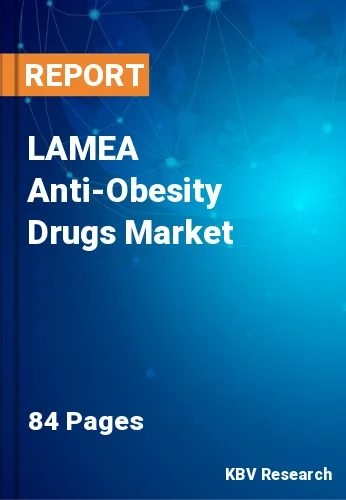The Latin America, Middle East and Africa Anti-Obesity Drugs Market would witness market growth of 14.9% CAGR during the forecast period (2023-2029).
Prescription drugs can aid in weight loss and maintenance for certain people when accompanied by behavioral modifications like healthier eating and increased exercise. People who use prescription drugs in conjunction with a lifestyle program typically lose more of their beginning body weight after a year than those who do not use prescription drugs. Some persons who use prescription weight-management drugs see a weight loss of 10% or more compared to their beginning weight. By lowering blood pressure, blood sugar, and lipid levels, weight loss of 5% to 10% of the initial body weight may assist the person's health. Additionally, certain additional health issues linked to being overweight or obese, like joint pain and sleep apnea, can be improved by losing weight. Within the first six months of using the medicine, most weight loss occurs.
The estimated range of diabetes prevalence in Saudi Arabia was between 9% and 22% from 1980 to 2008. It is estimated that there are approximately 7 million individuals with diabetes and an additional 3 million in the prediabetic phase. The prevalence of this region is being impacted by various factors, including unhealthy lifestyles, genetic susceptibility, and an increase in the incidence of type 2 diabetes mellitus among young adults and children. The rise in diabetes is anticipated to boost the utilization of anti-obesity drugs as they are efficient in countering diabetic illness, especially in people who are also suffering from obesity, increasing the market growth in the region.
The Brazil market dominated the LAMEA Anti-Obesity Drugs Market by Country in 2022, and would continue to be a dominant market till 2029; thereby, achieving a market value of $64.5 million by 2029. The Argentina market is experiencing a CAGR of 15.5% during (2023 - 2029). Additionally, The UAE market would display a CAGR of 14.6% during (2023 - 2029).
Based on Drug Type, the market is segmented into Prescription Drugs and Over The Counter Drugs. Based on Mechanism of Action, the market is segmented into Centrally Acting and Peripherally Acting. Based on Route Of Administration, the market is segmented into Oral Route and Subcutaneous Route. Based on Distribution Channel, the market is segmented into Hospital Pharmacies, Retail Pharmacies, and Online Pharmacies. Based on countries, the market is segmented into Brazil, Argentina, UAE, Saudi Arabia, South Africa, Nigeria, and Rest of LAMEA.
Free Valuable Insights: The Worldwide Anti-Obesity Drugs Market is Projected to reach USD 3.1 Billion by 2029, at a CAGR of 10.6%
The market research report covers the analysis of key stake holders of the market. Key companies profiled in the report include Pfizer, Inc., Boehringer Ingelheim International GmbH, GlaxoSmithKline PLC, Novo Nordisk A/S, Rhythm Pharmaceuticals, Inc., Gelesis Holdings Inc. (PureTech Health), Currax Pharmaceuticals LLC (Currax Holdings USA LLC), Vivus LLC, CHEPLAPHARM Arzneimittel GmbH (Braun Beteiligungs GmbH) and KVK Tech, Inc.
By Drug Type
By Mechanism of Action
By Route Of Administration
By Distribution Channel
By Country
Our team of dedicated experts can provide you with attractive expansion opportunities for your business.

